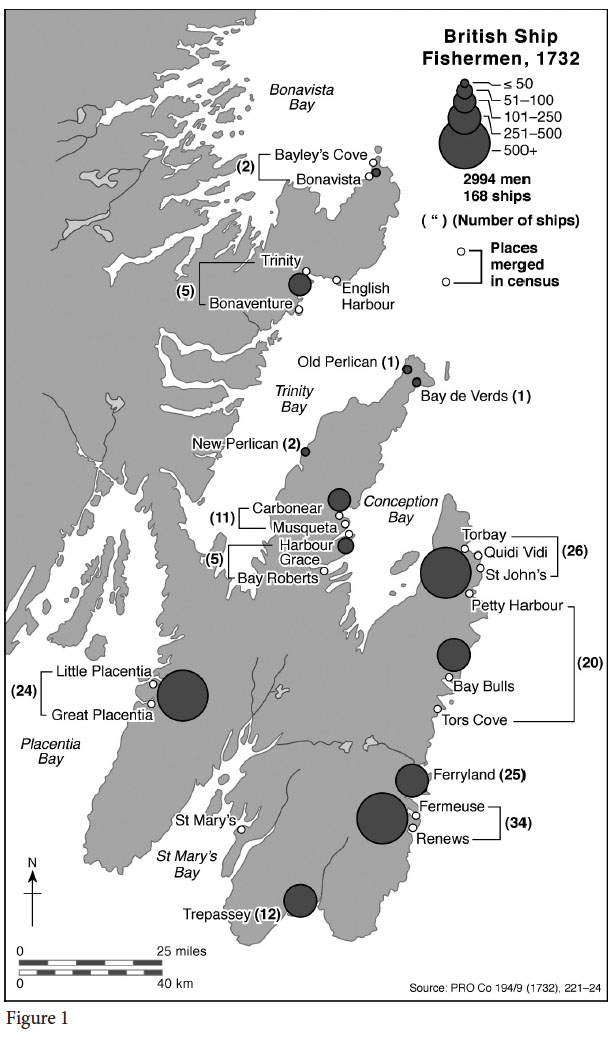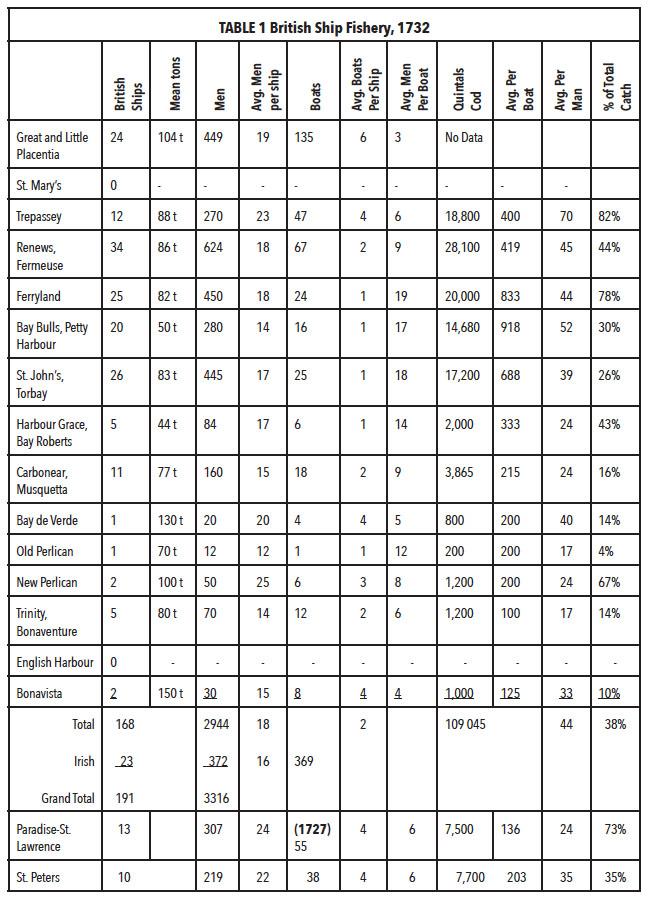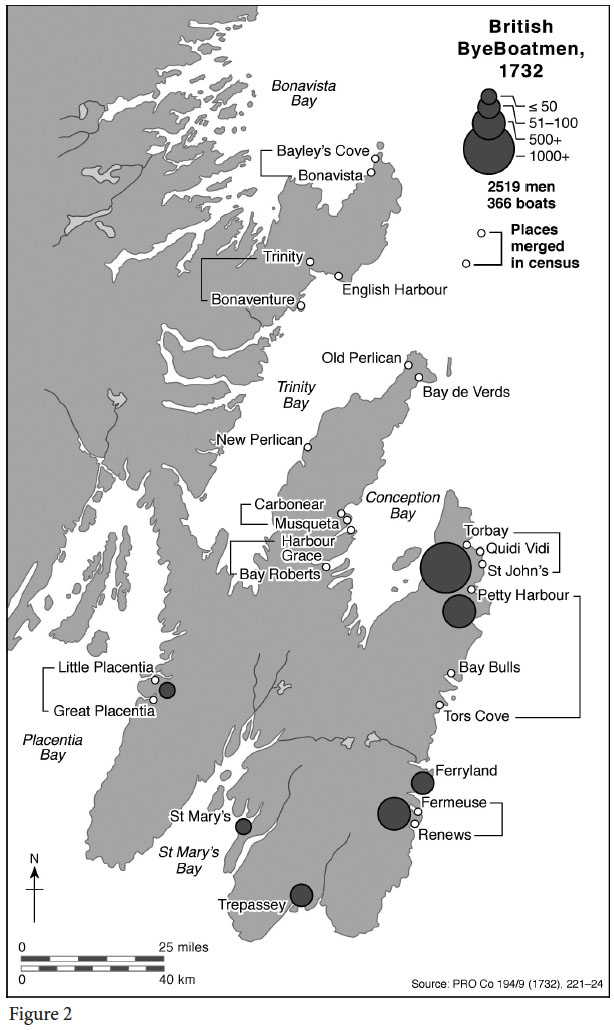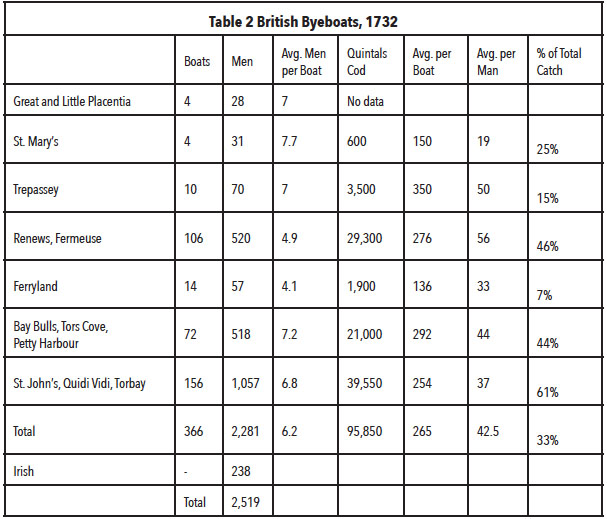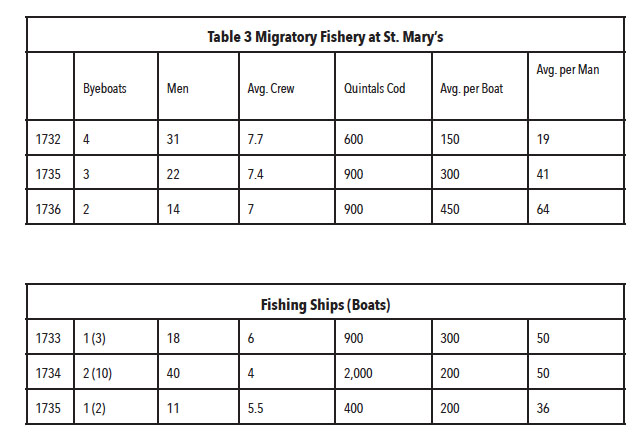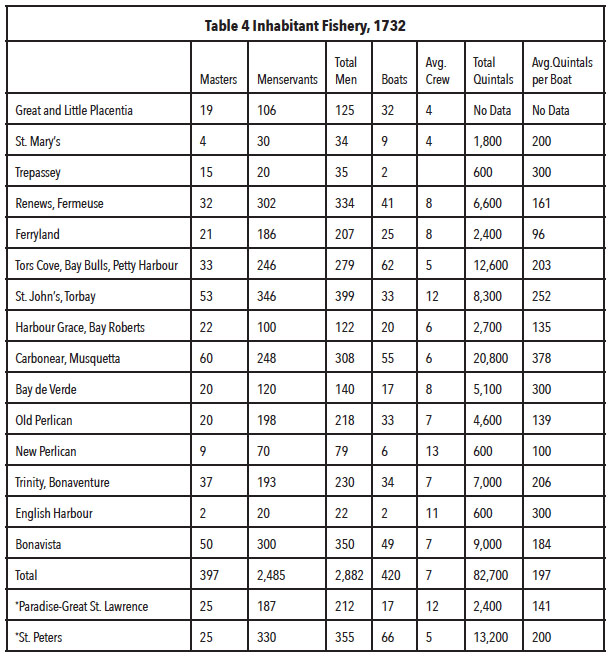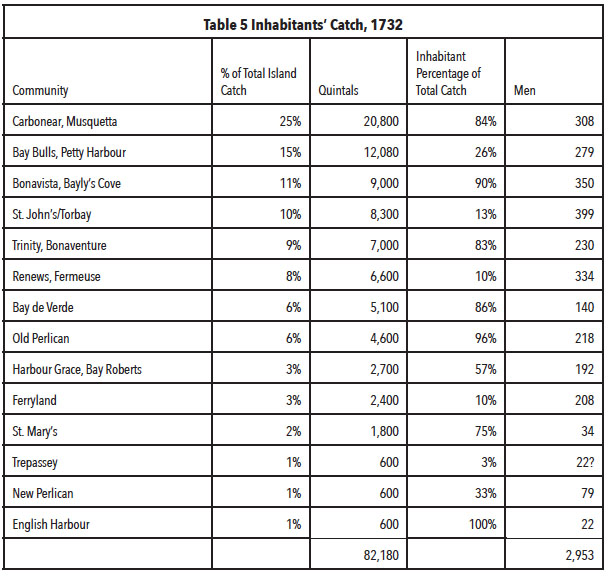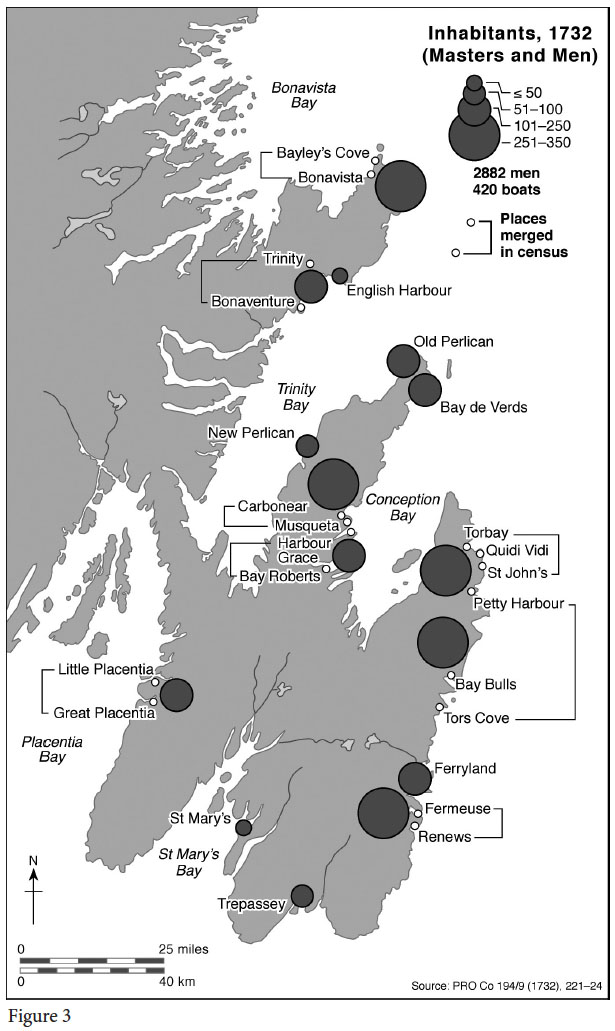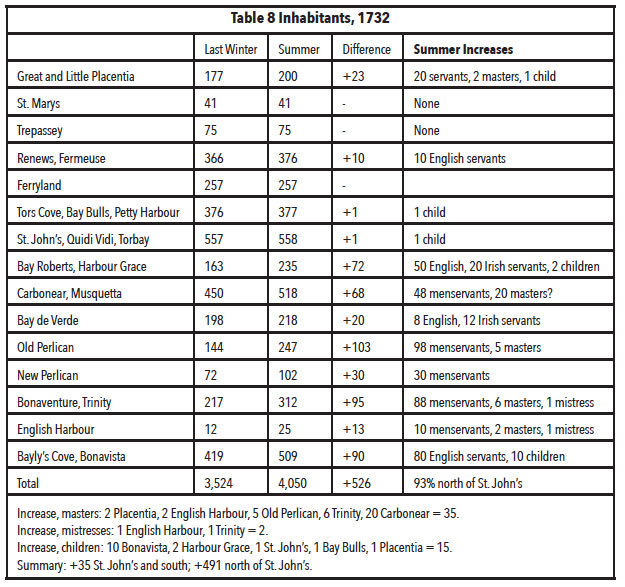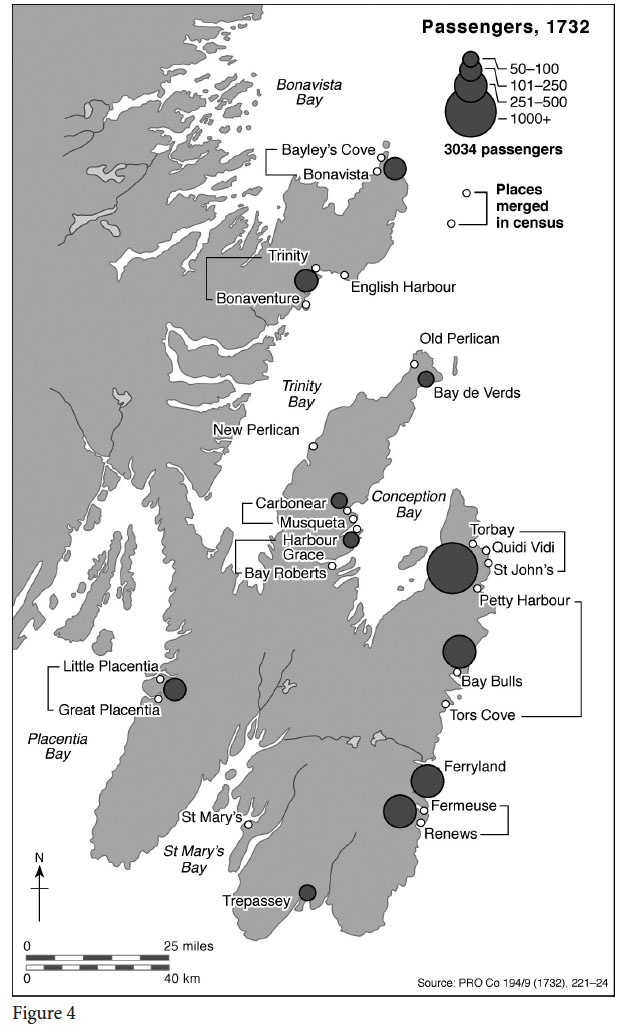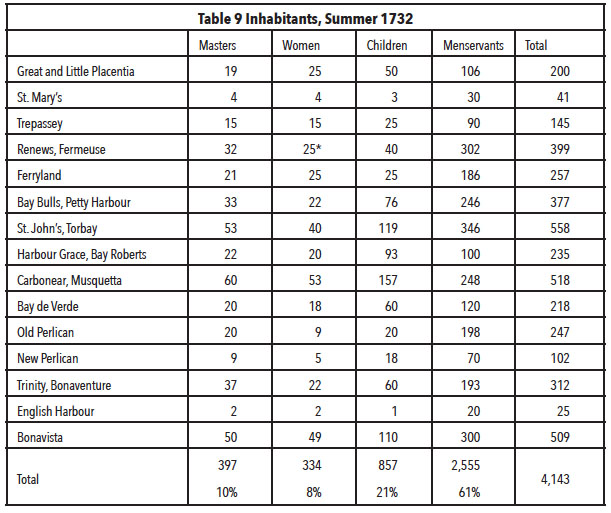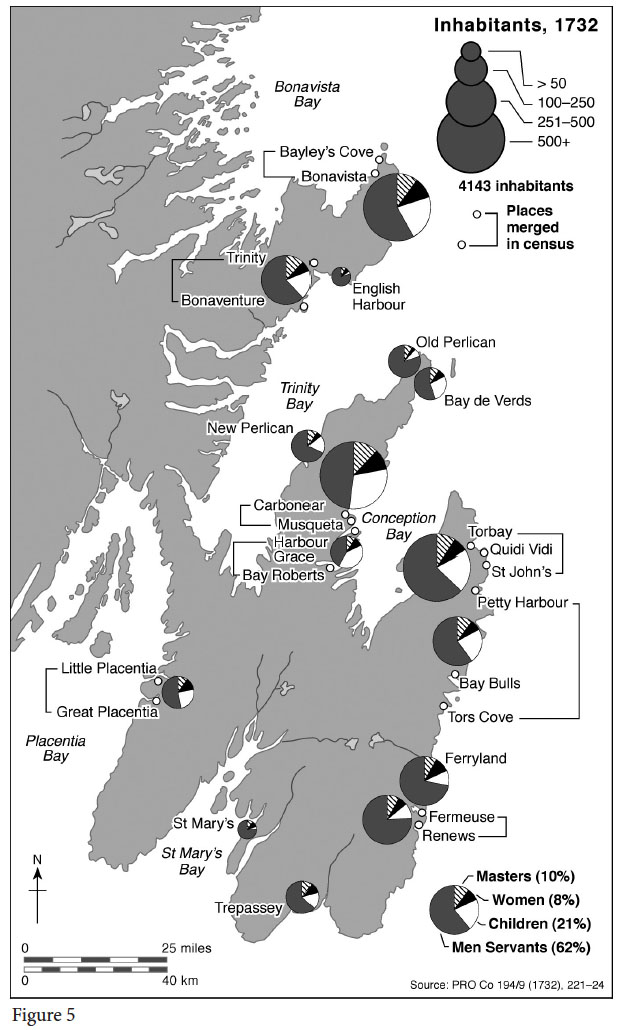Articles
Population and Economy:
Geographical Perspectives on Newfoundland in 1732
1 On 27 April 1732 the Duke of Newcastle informed the Council of Trade and Plantations in London that the King had approved the appointment of Edward Falkingham as governor of Newfoundland. Falkingham had been a captain in the Royal Navy since 1713, and already had served as a commodore on the Newfoundland station.1 In mid-May 1732 the Admiralty requested and received copies of Falkingham’s Commission and Instructions, including the traditional “Heads of Inquiry,” a detailed list of questions on the state of the fishery.2 Focusing primarily on the cod economy, the queries also covered a wide range of demographic and social aspects of life on the island, particularly during the summer. The detail matched anything reported for British possessions elsewhere in North America.3
2 Annual returns from British commodores and governors have formed the basis for a rich historiography on Newfoundland from the late seventeenth century through the eighteenth century.4 Most authors choose several decades from the “scheme of the fishery” to determine general temporal trends in, for example, population growth or cod production. They acknowledge inconsistencies, errors, and omissions in the data that can sometimes reduce one to speculative comment. Among my objectives here is to reassess the reliability of the statistical returns and official commentary by focusing on a single year. Falkingham is chosen because his was probably the best account submitted since the turn of the eighteenth century. Falkingham’s answers to the numerous queries, and his statistical Scheme, must be set in the context of those yearly reports submitted by his immediate predecessors, particularly Lord Vere Beauclerk (1728-30), Governors Osburn (1729-31), Clinton (1731), and Falkingham’s successor, Lord Muskerry (1733-34).
3 All were of aristocratic or upper-middle-class origins in England, or, in the case of Muskerry, southern Ireland. They were educated and experienced men who had moved up the ranks of the British navy to the status of commanders of squadrons in Atlantic and Mediterranean waters. Their tour of duty in Newfoundland extended beyond protecting a merchant fleet. Yearly reports responded to more than 65 queries on conditions in Newfoundland, and over 50 categories of data were tabled by district, and sometimes by individual harbour or cove, along the English shore. One can reconstruct from these statistics the regional patterns of the cod economy, from the numbers of ships and boats and men fishing and trading to the distribution, between Placentia and Bonavista, of year-round inhabitants, the masters, menservants, mistresses, women servants, and children. These data are presented here in a series of maps and tables for 1732, and a preliminary analysis of Newfoundland’s historical geography is offered.
BACKGROUND
4 Newfoundland, in 1732, was overwhelmingly occupied by persons of Protestant English birth or descent. From around 1720 onward, however, Catholics from southeast Ireland were recruited by sea captains en route to the fishery from their home ports in the southwest of England. Some of these young Irishmen began to stay the winter, causing considerable alarm among colonial administrators. A flurry of complaints from commodores, governors, resident magistrates, and other British officials prompted a request from the Colonial Office to Falkingham to include a count of the Irish in his yearly report. This he did, and it is the first of record distinguishing English from Irish on the island.5 Indeed, there is little comparable ethnic data surviving for any other British colony in the North American mainland.
5 Falkingham departed London for Newfoundland on HMS Salisbury early in June. He arrived at Great Placentia on 13 July 1732. Placentia was, after St. John’s, Newfoundland’s leading harbour, and was the only place with a fort and garrison on the island. Falkingham assembled the principal planters and fishing masters there, read his commission, and had it posted. He then took command of the fort and garrison. Samuel Gledhill was Lieutenant-Governor of the garrison. He had used his position to take over extensive property — the fishing rooms of the migratory fishing masters out from north Devon — in the harbour. Some rooms were leased out by Gledhill to soldiers and other personnel in the garrison, some to resident boatkeepers or planters, and some to masters of the fishing ships. All were leased at exorbitant prices. A decade of litigation and petitions over property rights and tenures made the harbour and great beach at Placentia the most documented place on the island.6 Falkingham’s predecessors recorded the conflicting interests of planters, fishing ships, and the military with their claims and counterclaims of dispossession or destruction of wharves, warehouses, and cookrooms. By 1732 Falkingham could report that the garrison no longer interfered in the fishery. Conflict continued, however, between resident and migratory fishing interests over rooms, and between resident magistrates, naval commodores, and fishing admirals over governance. It was replicated in most large harbours throughout the island.
6 The garrison was quartered in Fort Frederick on the south side of the gut or entrance to the harbour. Built by the British after the Treaty of Utrecht in 1713, it replaced the much larger French site of Fort Louis, across the gut in (modern) Jerseyside. Gledhill held the status of Lieutenant-Governor, reporting to Richard Philipps, Governor of Nova Scotia at the sister garrison in Canso. Partly because of a reduced French threat to the English fishery at Placentia and the south coast generally, Gledhill’s once considerable garrison was reduced to a single company. With the appointment of Henry Osburn as the first governor of Newfoundland in 1729 the administrative link with Nova Scotia was also severed. As commander-in-chief Falkingham’s first duty was to inspect the garrison at Fort Frederick, take a census, and report on the state of its defences. The muster roll includes 47 names. Most of the senior positions, including the fort major, judge advocate, commissary, surgeon, and chaplain, were vacant. A small detachment of the Royal Regiment of Artillery included a sergeant, a storekeeper, gunners, carpenters, a mason, and a blacksmith.7 Placentia and Canso, the latter a centre for a flourishing summer fishery out of New England, and Port Royal (Annapolis) were the only fortified harbours in what became English Canada. This meagre defence reflected a period of peace with the French and the limited nature of settlement by the British.
7 Following two weeks in Placentia, Falkingham proceeded to St. John’s. He already had despatched the navy’s second ship, Dursley Gally, there. A third ship sailed to Canso. On 30 July the governor sent his first report to London, enclosing details on the garrison at Placentia. He noted that the prospects for the fishery this season on the island looked “extraordinary.” Falkingham promised a full report on the fishery at the end of the season. In the meantime he proceeded with the day-to-day business of governance of St. John’s and the island. A court meeting in St. John’s was convened. It included the three admirals of the harbour, three magistrates, fishing shipmasters, planters, traders, and other prominent migrants and residents. As in Placentia his commission and instructions were read. There was only one change to the list of queries from those issued to Governor Clinton the previous year.
8 The summer was spent regulating day-to-day affairs of the fishery, assisting in the adjudication of disputes, and preparing replies to the articles or queries. Considering the level of detail it is surprising how little reference was made in the governor’s or other official correspondence on precisely how the information was gathered. Wells has noted similar lacunae elsewhere in North America.
9 There were 54 categories of data recorded for the scheme of the fishery in 1732. They ranged from the number of British fishing ships and men arriving in spring to the numbers of births and deaths on the island since “the last convoy,” i.e., October 1731. The census covered the east coast from Placentia to Bonavista. All the leading harbours are recorded. Some, notably Fermeuse/ Renews, Harbour Grace/Bay Roberts, and New Perlican are listed and counted for the first time since the beginning of the century. The 23 named places were grouped into 15 units for enumeration. In calibrating the returns, Falkingham had to deal with some 900 boxes of figures, excluding subtotals and totals.
10 On 4 October 1732, Falkingham wrote Allured Popple, Secretary to the Board of Trade and Plantations, from St. John’s enclosing “replies to his Instructions, for which he has taken all possible care to procure the best and most authentic intelligence”. Falkingham noted the geographical difficulties, “as the settlements are at so great a distance of 100 leagues as your lordships will see by the annext scheme of the districts.” He listed nine settlements on the western shore of Placentia Bay south to Burin and St. Peters with no data, noting in the blank spaces he had “sent Orders with a copy of the Scheme to the Admirals of these places, to send me an account of the fishery but they did not comply therewith.”8
11 Responses to the Heads of Inquiry and the accompanying scheme of the fishery improved substantially both qualitatively and quantitatively in the late 1720s and early 1730s. It was the result of a number of factors, not least the social status and expertise of the chief commodore, Lord Vere Beauclerk, and, from 1729, the governors appointed in London to serve as commanders of the Newfoundland station. Lord Vere acted as chief commodore for three consecutive years, 1728-30. He was joined in 1729 and 1730 by Henry Osburn, Newfoundland’s first governor. Jerry Bannister has convincingly identified these years as the beginning of a new era of British governance, and of improved reporting on the state of the island’s fishery.9
12 It is likely that by 1732 the resident magistrates assisted the admirals in gathering the statistics and providing answers to the Heads of Inquiry, particularly those queries relating to population and economy in the winter. Although they could wield considerable power, the admirals, historically the first three fishing shipmasters to enter a harbour in the spring, were much too busy with their fishery to spend much time compiling data for naval commodores or governors. Falkingham’s response was representative:
No magistrates or constables were appointed for the western shore of Placentia Bay, Burin, or St. Peters. It may in part explain the absence of any returns from this region until around mid-century. Failure to complete the census in 1732 prompted London to issue detailed instructions to Lord Muskerry the following spring:
Muskerry made no mention of these instructions in his annual report for 1733 but assured the Colonial Office he had attended to it the following year. An inspection of the scheme for 1734 reveals he did not. Settlements southwest of Placentia continued to be ignored. To the far north, Fogo and Twillingate are reported for the first time in 1733 but thrown in, curiously, with Bay de Verds (Bay de Verde) in Conception Bay. Bonavista is listed with Old Perlican in Trinity Bay. And Harbour Grace/Bay Roberts is not listed at all. Although Muskerry claimed he followed the instructions of Article 66 in 1734, there are no figures either for Fogo/Twillingate or Harbour Grace, but he did dispatch one of his naval captains to check on the French colony at Cape Ray on the southwest corner of the island. “Portabask” is included in the scheme, the only settlement west of Placentia listed. Uneven geographical coverage even over a relatively brief period poses problems when discussing either regional trends or island totals. Our graphs of the latter must come with a warning. A comprehensive account of Newfoundland’s yearly population and economy does not exist, at least not for the first third of the eighteenth century.
13 There were three fishing strategies or sectors. The oldest, and still the most important in 1732, was the migratory ship fishery. Based primarily in ports on the north and south coasts of Devon, and Poole in Dorset, the fishing ships and crews arrived each spring and anchored in the larger harbours from where smaller boats were deployed to catch cod, mainly inshore. Almost all personnel returned to England at the end of the season. The second strategy, the byeboats, was more recent in origin, an offshoot of the fishing ship’s system. Byeboatmen did not usually own ships. They arrived as paying passengers on the fishing ships, mainly from south Devon, and operated their own boats independently inshore. Byeboatmen also returned home in the fall. Finally, the inhabitant fishery, conducted by planters or year-round boatkeepers, was prosecuted in 60 or more settlements along the English shore. It was expanding at the expense of the ancient ship fishery in 1732. Each sector is now examined, its spatial dimensions outlined, and some preliminary analysis attempted.
THE BRITISH MIGRATORY SHIP FISHERY
14 Falkingham recorded 321 ships arriving in Newfoundland in 1732. Just over half of these (168) were classified as British fishing ships. They carried 2,944 men from England, an average of 18 men per vessel (Table 1). Recorded separately were 23 fishing ships arriving from Ireland, with 372 men. The ships anchored in more than 20 harbours between Placentia and Bonavista. At least 20 more fishing ships were located in harbours west and southwest of Placentia, from Paradise to St. Peters.12
15 The distribution of fishing ships and their “companies” [crews] directly from England was highly uneven geographically. Fully 85 per cent of all ships and men were concentrated in the southern half of the Avalon, between St. John’s and Placentia (Figure 1). Most of these were concentrated in seven large harbours: St. John’s, Bay Bulls, Ferryland, Fermeuse, Renews, Trepassey, and Great Placentia. Adequate water depth, safe anchorage (shelter), sufficient shore space for fishing ships’ rooms, and proximity to productive cod grounds inshore were the pre-eminent prerequisites for site selection and location. Lesser harbours such as Little Placentia, Cape Broyle, Witless Bay, Petty Harbour, and Torbay each hosted a handful of fishing ships, their numbers grouped with their larger neighbours in the returns. Some small harbours, such as St. Mary’s and English Harbour, had no fishing ships in 1732. Tors Cove, named in the census, was described in the late seventeenth century as “a place for boats to fish but not for ships to ride.”13
16 Environmental factors do not account for the paucity of fishing ships north of St. John’s. There were some excellent harbours, most notably Bonavista, but also Trinity, Old and New Perlican, Bay de Verde, Carbonear, and Harbour Grace. Only Carbonear had a modest fishing fleet. Everywhere “to the norwards” the planter fishery easily surpassed its migratory equivalent in 1732. South and north Devon dominated the ship fishery and focused overwhelmingly on the southern half of the Avalon. Poole and its ancillary ports in Dorset and Hampshire concentrated on the north-facing bays and on an inhabitant fishery. They accounted for no more than 15 per cent of the total fishing ships’ catch.
17 The contrast in fishing strategies between north and south in Newfoundland had deep roots. In a careful measurement for the period 1676-81, for example, Handcock has shown that roughly two-thirds of all fishing ships were located in harbours between St. John’s and Trepassey. Placentia (Plaisance) was at that time in the hands of the French. It, too, was overwhelmingly a ship fishery. There were fewer British vessels but almost twice as many men engaged in the ship fishery between 1676 and 1681. Governor Clinton described the transition in the fall of 1731:
The decline of the ship fishery was most notable at Bonavista. More than 400 men arrived there yearly in the late seventeenth century, mainly based in Bonavista Harbour but also scattered in smaller harbours around the bay, at Keels, Salvedge, Barrow Harbour, Fair Island, and Greenspond. Only two fishing ships and 30 men were recorded in 1732. Trinity Bay and Bay de Verde had also experienced a major decline. A decade earlier the commodores highlighted the environmental difficulties facing the migratory fishery in the north:
18 The fishing ships were tiny, their crews or companies small. More than twothirds of all ships fishing in 1732 were between 75 and 100 tons (Table 1), less than one-fifth were 100-150 tons, almost all at Placentia, and 15 per cent were below 50 tons. The number of men recorded “belonging to the British fishing ships” averaged 18 per ship in 1732. There were twice that number per vessel, on average, in the period 1676-81. Companies ranged from as low as 12 on a single vessel at Old Perlican, to a high of 50 men on two vessels at New Perlican, nearby.
19 Through the 1720s and early 1730s commodores and governors complained about fishing shipmasters ignoring the regulations regarding the legal requirement, laid out in the Act of 1699, of recruiting the quota of fresh men. These were youngsters, new to the fishery, seen by the colonial administration in London as potential recruits for the Royal Navy. “This article is very seldom observed,” Falkingham reported in 1732; “the Admirals tell us they demand the certificates from the masters of the fishing ships, but [from] what I can learn none or few have any regard for the act but such as expect to be Admirals themselves.” Before he cleared his home port in the West Country, a master was supposed to procure a certificate from Customs affirming that the legal complement of green men were aboard. Such monitoring of migrants in a highly informal, vernacular, and flexible enterprise, where men could move from one sector to another, was never likely. Nor was Falkingham’s recommendation that returnees be counted in the fall to ensure the ship fishery was a seasonal venture only. Generally half of all ships did not return directly to their home ports. His concerns were illicit overwintering and migration to New England.
BOATS FISHING AND CREWS
20 For two centuries the predominant boat catching fish in Newfoundland waters, irrespective of Western European origins, was the shallop (chaloupe, chalupa). The fishing crew comprised three to five men. It generally included the boatmaster, midshipman, and foreshipman, with one or two youngsters new to the fishery. They operated inshore. The boat was the primary unit of measurement for the English cod fishery through the seventeenth century. It is prominent in the literature.16 Fishing ships’ companies were deployed in boats on arrival, with men ashore splitting, salting, and curing the cod. The number of boats per ship could vary. Falkingham’s example of a 100-ton vessel with 10 boats and 50 crew (five per boat) as the model was derived from seventeenth-century reports repeated by commodores and governors, albeit archaic by 1732. Both Vere and Falkingham reported four men per boat, Lord Muskerry five.
21 Irrespective of sector — fishing ships, byeboats, planters — boatkeepers were a distinct class, separate from the mass of menservants they employed. Falkingham reported it cost £120 to fit out and maintain a boat (technology, salt, supplies, labour) for a season. Wages varied from £4 to £25, depending on skill. For experienced men, wages were high. A boatmaster could earn £15-£17, a midshipman £12, a foreshipman £11.17 Skilled splitters and salters could earn up to £16 ashore. These rates were more than double those of equivalent artisans in home ports like Dartmouth and Poole. It remained the single most important motivation for transatlantic migration over three centuries. For inexperienced youngsters freshly recruited, however, the low rates of pay were barely enough to survive.
22 The traditional shallop operating inshore was still common in 1732. A single fishing ship at Bay de Verde, larger than most, carried 20 men (Table 1). They operated four boats and caught 800 quintals of fish, an average of 200 per boat and 40 per man. It was close to the averages reported in the seventeenth century by commodores and others, and to the figures generally reported in the literature. There was also a single fishing ship at Old Perlican, much smaller with a tiny company comprising 12 men. They also are recorded with one boat, again catching 200 quintals. If all 12 men were crew, then it is too high for a traditional shallop. Their average catch would be only 17 quintals per man. This would make for an unprofitable voyage. If the figures are correct, it raises the possibility of some servants reported as belonging to the fishing ships deployed elsewhere or moving in to work for planters in the inhabitant sector. At Bay de Verde, described in the seventeenth century as “a small, dangerous cove,” the migratory ship fishery accounted for only 4 per cent of the total catch in 1732. The rest was attributed to the inhabitants.
23 Almost three-quarters of all fishing ships had only one or two boats in 1732 (Table 1). They were concentrated in harbours between St. John’s and Renews. One boat per ship is recorded for St. John’s, Bay Bulls, and Ferryland. There were 71 fishing ships in these three harbours, and 65 boats. Crews per boat averaged 17-19 men. This was three to four times the crew complement typical of shallops inshore. These larger craft were schooners, fishing on the banks. Catches offshore ranged from 700-900 quintals per boat. It is possible that some of the 70 or more transatlantic fishing ships in these harbours were themselves converted to banking schooners. Falkingham did make reference to ships fishing in 1732. It is also likely that schooners undertook more than one fishing voyage to the banks. These three harbours alone accounted for almost half the fishing ship catch. It does not mean that the traditional seventeenth-century shallops had been completely abandoned. Fermeuse/ Renews had the highest number of fishing ships, men, boats, and catch in 1732 (Table 1). There were two boats per vessel. Boat crews averaged nine men, the catch per boat 419 quintals. Fishing shipmasters in these two harbours likely deployed both schooners on the banks and shallops inshore. North of St. John’s, the average catch per boat for the fishing ships, Harbour Grace excepted, was only 100-215 quintals. They fished inshore.
24 Diversification in the fishery along the English shore to include the Grand Banks developed only after the Treaty of Utrecht (1713). New Englanders had been engaged fishing offshore since at least 1675. In a rare reference by a Newfoundland commodore, Lord Vere described their fishery at Canso in 1729. There were “no boats, but scooners of about 40 tons, and 5 men.” Vere did not say this about Placentia, where he had anchored each summer from 1728 to 1730. Clinton was clear on the growth of Newfoundland fishing offshore. “We have great quantities of Bank fish this year,” he reported on 29 July 1731 from St. John’s, “even greater than has been known these three years past, but the boat fishing is very bad.”18 Falkingham also noted the vessel distinction: “what fish is taken by the Boats near the shore is most esteemed, the fish taken in the Banks, by the ships etc. lying long on board, is apt to take on damage.”
THE SHIP FISHERY AT PLACENTIA
25 When Falkingham arrived directly from England at Great Placentia in July 1732 there were over 700 men engaged in the fishery there and in neighbouring harbours. Fully 80 per cent of these men “belonged” to the ship fishery. They came primarily from the ports of Bideford and Barnstaple in north Devon. There were 24 fishing ships with 135 boats and 449 men. A further five vessels came via southeast Ireland with 114 men. They operated 20 boats. Placentia had by far the largest number of boats and, on average, the smallest crews in the ship fishery in 1732. With fewer than four men per boat, it is unlikely that there was any midshore fishery or any activity on the Grand Banks.
26 From 1714 on, Placentia and St. John’s were the two most frequented harbours by chief commodores and later governors. In 1729 and again in 1730 both Lord Vere and Henry Osburn, the first governor, anchored at Placentia; so did Governors Clinton, Falkingham, and Muskerry between 1731 and 1734. Their reports and yearly returns, together with those by Samuel Gledhill, the resident Lieutenant-Governor of the garrison, meant that Great Placentia was the best-reported settlement on the island. Because of its splendid natural harbour, extensive anchorage, and spacious beach for drying cod, Great Placentia was the major centre for the ship fishery on the south coast. It had been since the sixteenth century when the French Basques established a huge dry fishery there. They were succeeded by the English after 1713. Little Placentia was also a fishing ship harbour, small in comparison to that in Great Placentia. Commodore John St. Lo, in a detailed census for 1727, reported 25 fishing ships at Great Placentia but none at all in the smaller harbour nearby.19
27 The fishery at Placentia involved a three-way contest among shipmasters out yearly from north Devon, the resident planters and traders, and the garrison. Lieutenant-Governor Gledhill had gradually gained control over much of the great beach. He rented out fishing rooms there to the migratory masters, the planters, and officers from the garrison. Gledhill also entered the fishery directly, building boats and hiring men to fish. He also built ships at Placentia and engaged in overseas trade.
28 Gledhill’s monopoly was challenged by English shipowners and fishing shipmasters. A petition from merchants in London in 1723 complained about officers from the garrison interfering with the fishery “and more particularly by Saml. Gledhill, Lt. Governor of Fort Frederick in Placentia, who for several years past, and particularly the last year carried on the fishing trade . . . in all its branches, having employ’d several ships of his own and on his particular account freighted with goods from thence to foreign parts.” Similar petitions were dispatched from migratory ship fishing interests in Bideford, Barnstaple, Bristol, Dartmouth, and Poole.20 Stages, stores, and cookrooms belonging to the migratory men were dismantled during their absence in winter for fuel. In 1728 Richard Newell, mayor of Barnstaple, and “nine of the principal inhabitants there” complained to the Council of Trade and Plantations:
London did respond, and the instructions in the spring of 1729 to the first governor, Henry Osburn, addressed specifically the problems at Placentia:
The earliest surviving court records for eighteenth-century Newfoundland come from Placentia. In May 1730 the three admirals there held a session at the house of Francis Sayers. Their authority was contested by the three magistrates, Thomas Salmon, Peter Signac, and Thomas Buchanan, resident planter-traders. Most of the disputes were between shipmasters and their servants, and with the planters. They centred on wages, contracts, and property rights. Osburn was highly critical of the fishing shipmasters:
29 Osburn’s 33 memorials (informal reports) name 56 persons in 1730, including nine fishing shipmasters, some of their servants, and some planters. They provide perhaps the best record of society and economy for the British ship fishery in the first third of the eighteenth century. It was a world dominated by credit, debt, and social deprivation. An English servant, Edward Buck, was hired by a fishing ship captain, George Hogg, “at share and portage either to go to market or tarry here.” Buck claimed he was denied his share of “the common adventure” and his wages, and was assaulted by the fishing ship’s mate and two crew. The reasons for this conflict are not given, nor is there any record of resolutions in Osburn’s memorial. Incomplete as the record is, it does suggest a labour contract that included wages and portage, the latter originally a right to ship cargo, later a cash payment.24 Both Vere and Falkingham noted that only the fishing ships from north Devon persevered with shares. Such a system worked when servants and shipmasters came from the same place. It was less suited to the Irish. Yet an Irish migrant, Daniel Mahanney, agreed to serve Captain Bartholomew Shapton for £9 “portledge and share sterl. etc.” Mahanney came down with a fever and was, like Buck, denied remuneration.
30 Captain William Fulford’s contract with another Irish migrant, John Sullivan, was more representative. Sullivan was hired 2 June 1732 in Placentia for the season at £6 wages plus his passage home. It was very late in the season for a contract. He had reached Placentia on another ship, probably that spring. Commodores and governors, including Falkingham, decried the practice of fishing shipmasters hiring the Irish “on the spott” in Newfoundland. They rarely became seamen, or even good fishermen. Six weeks after being hired Sullivan fell sick and was abandoned by his employer, leaving him “destitute.”
31 Placentia’s inhabitant fishery was small when compared to that of the fishing ships, but increasingly the latter depended on resident proprietors for space to process their catch. Thomas Buchanan, a resident trader and magistrate at Great Placentia, protested over no fewer than four migratory shipmasters who either forcibly occupied his properties or refused to pay him rents.
32 It was an oral culture where documentary evidence of ownership or rights to rooms was rare. Falkingham reported the rent for a boat’s room ranged from £6-£8 a season and that a fishing room could accommodate up to six boats. This was the average number of boats per fishing ship at Placentia in 1732.
33 A fishing shipmaster from Barnstaple, William Babbage, appropriated a room “on the Great Beach” claimed by Peter Signac and leased by him at £30 a year. Signac, originally from Boston and of Huguenot background, had relocated to Placentia prior to 1720. He was a merchant also engaged directly in the fishery. Between 1721 and 1727 Signac had a fishing room at Le Perche, near [later] Distress Cove [modern St. Brides] on the Cape Shore. The beach there had been used for the preliminary drying of fish by the French. It was a mid-shore station most likely for fish from the rich grounds off Cape St. Marys. Signac leased La Perche to a Bideford shipmaster, Samuel Burrowes. It is the earliest reference to any occupation along the Cape Shore by the British, and a rare reference to any schooner fishery out of Placentia by them in the early eighteenth century.
BYEBOATMEN
34 Occupying an intermediate position between the fishing ships and the resident planters, byeboatkeepers were based in Britain, travelled each spring with their crews as paying passengers on the fishing ships, and kept one or more boats in Newfoundland. Byeboatmen fished in skiffs and shallops inshore, alongside the ship fishermen and planters. In the fall, they went home.
35 Byeboats, byeboat masters, and servants were recorded each year in the scheme, together with their catch. Their fishery originated in the 1660s, but, compared to the ship fishery, was small until after 1700. It was an offshoot of the traditional ship fishery conducted by men who either lacked the capital to own or operate ships, or who were unwilling to risk it in large-scale transatlantic company ventures. A communication from the Council on Trade and Plantations to the King in 1728, based on the report of Lord Vere, succinctly outlines its evolution:
Their numbers rose rapidly after 1720. “It is computed,” the Council continued, “that the by-boatkeepers and inhabitants do, communibas annis, catch as much fish as the merchant adventures.” In 1732 byeboatmen accounted for one-third of the total catch; the fishing ships had dropped to below 40 per cent.
36 From its inception the byeboat fishery was concentrated geographically both at home and in Newfoundland. Almost all came from south Devon, from the ports and hinterlands of Teignmouth, Dartmouth, and Torquay.26 Through the seventeenth century St. John’s was the core of the byeboat fishery, but by 1732 it had spread south along the shore to Renews, with smaller concentrations along the south coast (Figure 2). Over 90 per cent of all byeboats, crews, and catches were confined to three localities: St. John’s, Bay Bulls, and Fermeuse/ Renews. There were no byeboats recorded north of St. John’s/Torbay in 1732.
37 Byeboatmen tended to set up in smaller places where the fishing ships could not easily go: Torbay, Quidi Vidi, Petty Harbour, Witless Bay, Tors Cove, Bauline, Brigus South, Caplin Bay, St. Mary’s, and Little Placentia. Most byeboatkeepers rented their rooms from the planters. Falkingham noted that they avoided competing for ships’ rooms and paid planters £7-£9 rent for a single boat’s space. Byeboatkeepers could clear new rooms, but such a task would consume valuable fishing time for small crews and, as settlements grew, good shore sites became less available. Even the fishing shipmasters rented rooms from the inhabitants.
38 Byeboat crews generally averaged seven men in 1732. It was higher than the traditional five-man crew reported by officials and cited in the literature. Fermeuse/Renews did have five crew, and Ferryland only four men per byeboat (Table 2). In contrast to ship fishermen and planters, little is known of individual byeboatkeepers, masters, or servants. Despite their rising prominence, there are no nominal lists for the first third of the eighteenth century or explicit reference to them by name in the reports of commodores and governors between 1728 and 1734. Since the technology of catching and curing cod was common to all three sectors inshore, byeboatkeepers were not easily distinguishable, at least from planters, in a cove or harbour. One must resort to the statistics to get a sense of the scale of byeboat operations. This is best achieved by examining a small harbour where their numbers, and those from the other sector or sectors, were low.
39 There were four byeboats in St. Mary’s in 1732, with four masters and 27 menservants. One assumes the byeboatmen arrived on a fishing ship or ships at nearby Trepassey. Beside them were four resident masters with 30 men. No fishing ship was present, and no “passengers” were recorded to complicate the migratory figures. The total catch was 600 quintals, averaging 150 quintals per boat and less than 20 quintals per man. If accurate, then it was a failed fishery. By contrast, the inhabitant catch at St. Mary’s exceeded 50 quintals per man in 1732. The most plausible explanation is that part of the byeboat catch was mixed in and reported with that of the planters. Inconsistencies in ratios and averages in marginal places like this are relatively rare.
40 There was no byeboat fishery at St. Mary’s over the subsequent two seasons, but the average catch did increase in 1735 and 1736 (Table 3). Clearly, catches were rounded and the total catch may have been derived by selecting average catches per boat — 150, 200, 300, 450 quintals — and multiplying by the number of boats. Over three years, the number of byeboats and crews are small and consistent. The statistics are almost certainly reliable here, as are those for the handful of fishing ships appearing over three years with their boats and men. They had smaller boat crews on average, but generally similar catches to the byeboats. Without nominal lists one cannot measure it, but labour mobility between migratory sectors was relatively easy and likely. All came from the same place in England, one sector a parent of the other.
41 For the years when records are available for Placentia, byeboat catches did not exceed 3 per cent of the total catch. There were only four byeboats recorded in 1732, and 28 men, 5 per cent of all engaged in the migratory fishery that season. It was based in north Devon where, for whatever reasons, the byeboat strategy never took root. There were few if any byeboats in the harbour of Great Placentia, where the fishing ships from Bideford and Barnstaple anchored and shipmasters deployed their boat crews. Competition for rooms was intense. Small-scale independent migratory operators tended to be deflected to lesser harbours and coves. In 1727 Commodore John St. Lo recorded 11 byeboats in Little Placentia, with 55 men, but none at Great Placentia. Byeboat crews in Placentia ranged from five to seven men, larger than the boats deployed from the fishing ships.
42 It is difficult to explain the general geography of byeboatmen in Newfoundland. There were sharp contrasts. Why were over 90 per cent of them confined to a strip of shore stretching from St. John’s to Renews, with a smaller outlier at nearby Trepassey, and hardly any west of there, along the south coast? The concentration along the east coast from St. John’s to Renews is in part explained by the regional origins in England of the ship fishery. It was dominated by vessels from Dartmouth, Teignmouth, Torquay, Torbay, and Plymouth, also the core area for many years of the byeboat fishery. Ships from these English ports were less evident north of St. John’s or along the south coast. More than 1,000 byeboatmen arrived in St. John’s harbour in 1732 on the fishing ships from south Devon. They accounted for close to half of all crews in Newfoundland that spring. Most fished out of the harbour, side by side with the ship fishermen and the planters, but others moved to outports nearby, including Quidi Vidi, Torbay, and particularly Petty Harbour.
43 In St. John’s byeboatmen accounted for fully 60 per cent of the catch, compared to 27 per cent for the ship fishery and 13 per cent for the planters. As already noted, the ship fishery was conducted almost entirely by schooners on the banks, and ships’ rooms would be distinguishable from those of the byeboatmen and planters at least in everyday operations. Schooners were at sea for a week or more with three times as many men. They landed three times the average byeboat catch.
44 The byeboat fishery grew substantially in the first third of the eighteenth century. There were 156 byeboats in St. John’s in 1732, three times the number recorded in 1700. Almost certainly the great majority of boats were built locally during the winter by the inhabitants. Most inhabitants were also from south Devon, and could supply skiffs, shallops, and schooners to migratory masters. Falkingham and others noted the purchase of craft by migrants from residents. A shallop could fetch £20-£25. Profits percolated through the inhabitants’ economy.
45 South of St. John’s, the district of Bay Bulls, from Petty Harbour to Tors Cove, accounted for more than 20 per cent of the byeboat catch. Like St. John’s, Bay Bulls was a major fishing ship harbour but had a substantial byeboat operation. Byeboatmen arrived directly there from south Devon. They also dispersed to nearby coves and small harbours, where fishing ships did not usually go. Petty Harbour, for example, had twice as many byeboatmen as Bay Bulls in 1736. There was only one fishing ship there, with 40 men, compared to 280 byeboatmen. South of Bay Bulls, Witless Bay, Mobile, and Tors Cove all hosted byeboatkeepers and planters.
46 Byeboatkeepers were men of little capital who could not possibly prosecute a migratory fishery 2,000 miles from home without transatlantic transport and supplies. They were, as noted, provided by the fishing shipowners and masters, with sack ships to freight their cod to distant markets. Irrespective of how many boats they may have owned, byeboatkeepers were the middling men, between the shipowners and fishing shipmasters, on the one hand, and the mass of male servants, on the other. Their numbers were to grow substantially if sometimes erratically, over the next half-century.
THE INHABITANT FISHERY
47 Each year the scheme included a count of “the inhabitants distinguished by masters, men servants, mistresses, women servants [and] children” in summer. A second count referenced those “who remained in the country last year,” i.e., the previous winter. This second calibration was often erratic, either repeating the figures given for the summer for each and every category, or with just minor alterations that could not possibly cover the increases between winter and summer populations. The issue is discussed in some detail below. As in the case of the migratory fisheries, details of men, boats, and catch are included (Table 4).
48 The inhabitant fishery was conducted almost entirely by the resident masters and their men. Not all resident masters were planters engaged directly in catching and curing fish. A master was defined as a man who employed servants. Most were boatkeepers or planters, but masters could also be merchants, schooner traders, retailers (shopkeepers, publicans), craftsmen (coopers, carpenters), professionals, indeed, almost any occupation onshore.
49 Non-planters were concentrated in the large harbours by 1732, particularly in St. John’s but also in Carbonear, Trinity, Bonavista, Ferryland, and Great Placentia. In St. John’s, for example, there were 53 inhabitant masters, 346 menservants, but only 33 boats. They caught on average 252 quintals of fish per boat, standard for shallops working inshore. One may conclude that a substantial minority of inhabitant masters and men in St. John’s were not directly engaged in catching fish.
50 The geography of the planter fishery differed markedly from the migratory sector. Over 60 per cent of the total inhabitant catch was concentrated in harbours and coves north of St. John’s. Relatively few fishing ships, and no byeboats, operated there. Carbonear/Musquetta accounted for fully one-quarter of the island residents’ catch (Table 5). All but 16 per cent of the cod produced there came from the planters. There were 60 resident masters, 55 boats, and 248 menservants averaging 5.6 men per boat. As in St. John’s, not all inhabitant masters were planters or boatkeepers, but the great majority were. They caught on average 368 quintals of fish per boat, 68 quintals per man. It was an excellent catch, surpassing every other place recorded in 1732. Carbonear’s catch, for example, was eight times that of Harbour Grace/Bay Roberts to the south. Other settlements in this latter area were not listed, and perhaps not reported, in the census. They included Bryants Cove, Upper Island Cove, Port de Grave, Cupids, Brigus, and Harbour Main. None of these places in inner Conception Bay is reported in the scheme after the first few years of the eighteenth century. Even Harbour Grace did not appear again until 1738. It does reflect in part the relative paucity of the fishing grounds in the inner bay, but also perhaps the negligence of officials charged with compiling the scheme. The inhabitants’ catch at Harbour Grace had doubled by 1738, a more realistic return.
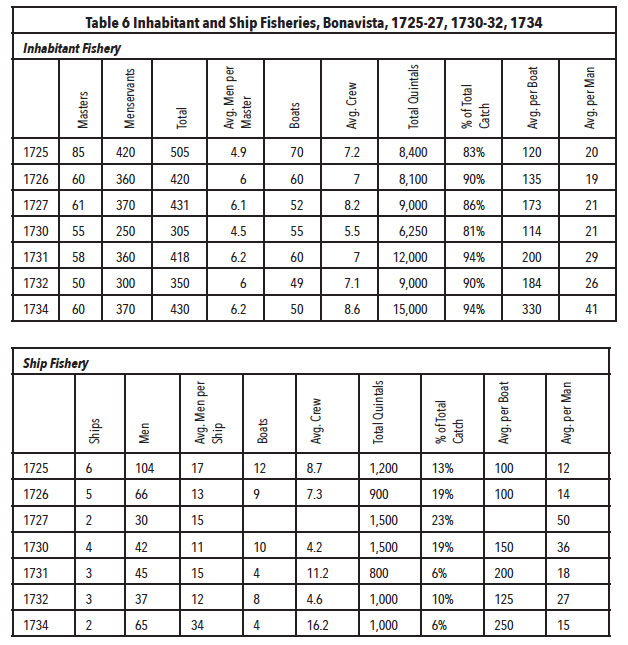 Display large image of Table 6
Display large image of Table 651 Harbours and coves north of Carbonear, centred at Bay de Verde, Old Perlican, Trinity, and Bonavista, accounted for one-third of the total inhabitant manpower and catch (Figure 3). As in Carbonear, the planters in each of these localities produced more than 80 per cent of the fish. At Bonavista, it was 90 per cent. There were 50 resident masters there with 49 boats and 300 menservants, 80 more than “the previous winter.” One may conclude these new men were drawn from the 120 “passengers” arriving in Bonavista that spring. The planters produced 9,000 quintals of cod. It was the third highest recorded for the island’s inhabitants in 1732.
52 We cannot be sure if the figures for Bonavista included the bay. Bayly’s Cove, just north of Bonavista Harbour, listed for the first time since the beginning of the century, was part of the count. There were at least six other yearround settlements with an inhabitant fishery in Bonavista Bay: Keels, Barrow Harbour, Salvedge, Silver Fox Island, Fair Island, and Greenspond. All were still tiny in 1732 and none was listed in the scheme.
53 Table 6 shows the figures for Bonavista’s fishery, both resident and migratory, over seven years when they can be compared. Statistical anomalies do occur, but they are surprisingly few. Apart from 1725, the number of resident masters ranged from 50 to 60. They represented a stable core, at the heart of the planter fishery. As in Carbonear, each had on average of one boat with five to six men. They fished inshore. Average catches per boat and per man were modest. So were those belonging to the small if fluctuating ship fishery. It involved two to six ships, and 30-100 men.
54 While Bonavista dominated the far north through the late seventeenth and early eighteenth centuries, the capacious harbour at Trinity was the centre of activity along the west side of Trinity Bay. In 1732 there were separate returns for Trinity/Bonaventure, English Harbour, and Old and New Perlican across the bay. These returns represented the most detailed geographical breakdown since the beginning of the century.
55 With only two planters, English Harbour was the smallest permanent settlement recorded separately for the island in 1732. Its presence in the returns probably reflects its location on the outer margins of places along the shore northeast of Trinity Harbour, which included the much larger fishery sited at Salmon Cove (modern Champneys). South of Trinity were Trouty, Old Bonaventure, and Little Hearts Ease.
56 Although not as populous or productive as Bonavista, Trinity was the primary place along the western shore of Trinity Bay. Three magistrates and three admirals were there in 1732, as well as an Anglican church and a resident minister. Governor Falkingham sent one of his naval officers, Lieutenant C. Steevens, to Trinity in September to settle a dispute over judicial powers between the admirals and the magistrates. The dispute involved the 1730 incarceration by the magistrates of a fishing admiral’s servant. On their return to Poole, the informal capital of Trinity, the admirals petitioned the mayor there for redress. It was passed on to London and eventually to the office of the colonial governor. As far as the admirals in Trinity were concerned, the lines of communication and administration ran from Trinity to their home port in Dorset, not to the governor and his naval officers based in St. John’s. Official links with the “norwards” were more tenuous than those with the southern half of the Avalon. Lord Vere complained in October 1729 that “the Admirals of Bonavista, Trinity, and Carbonear harbours have not sent me their accounts tho’ I writ twice for them.” In 1731, Governor Clinton sent Lieutenant Richard Hughes with instructions to proceed to several harbours in the north to assist the fishing admirals in determining disputes, preventing illegal trade, punishing offenders, and obtaining information for answers to the Heads of Inquiry. The admirals held at least one court session at Trinity in 1732 to determine with the planters and other migratory masters “the harbour price of fish.” They also considered disputes over property and wages.
57 Among the planters and resident traders, the magistrates were probably the best informed on Trinity’s population and economy, particularly through the winter. They were likely the leading informants, with the Anglican minister, in the completion of responses to the admirals and naval officers for the Heads of Inquiry, and for the statistical scheme.
58 There were 37 inhabitant masters, 193 menservants, and 34 boats recorded at Trinity/Bonaventure. Averaging seven crew and 206 quintals per boat, Trinity was typical of the inshore fishery. Bonavista boasted a superior location in relation to productive fishing grounds. There were more boats and men there than in the more capacious harbour at Trinity (Table 4). For much the same reasons, Carbonear surpassed Harbour Grace in Conception Bay.
59 Making sense of the numbers is less difficult in tiny places like English Harbour. There were two houses, two planters, two boats, a single stage, and 20 servants. No migratory fishery existed to complicate the returns. Nor were there any passengers recorded arriving in the spring, at least not directly. Yet the number of male servants there doubled for the summer fishery. Some had likely wintered locally in larger settlements; others perhaps arrived from England at Trinity that spring. We cannot be sure if all 10 winter servants actually remained at English Harbour for the summer season, only that 20 were recorded in the seasonal fishery. It was a large number for only two boats. They caught 600 quintals, 27 quintals per man, worth £405, and produced £56 worth of cod oil. This averaged out at £21 per man, comparable to £20 at Bonavista and £23 at Trinity, where crews were much smaller. Such averages are of little help in assessing individual earnings. Wages could range from £16 a season for a boatmaster or a splitter down to £3 for boys working ashore drying and storing the fish. Nor do we know, beyond two boatmasters and perhaps two midshipmen, precisely how servants were deployed in the boats and ashore. A specialist splitter or salter, for example, could serve more than one boat. Not all tasks were fixed. Men could move from one to another, particularly in the processing sector. Shoremens’ occupations are rarely mentioned in official reports.
60 Across the bay from Trinity, Old Perlican and Bay de Verde were, like Bonavista, in a pivotal position relative to productive cod grounds. Both were strategically located near the tip of the peninsula separating Trinity from Conception Bay. The settlements are five miles apart. Together these harbours were second only to Carbonear in the planter fishery to the north, ahead of Bonavista (Table 5). The fishery at Old Perlican was almost entirely residential. We do not know if the returns included settlements south of there, in particular Hants Harbour, Scilly Cove, and Hearts Content. Further south along the eastern shore of Trinity Bay, New Perlican is recorded in 1732, but not subsequently. In keeping with its location, it had a modest inhabitant fishery. Their catch per boat was the lowest on average reported for the island. Yet two fishing ships anchored at New Perlican with 50 men in 1732. They caught twice as much as the more numerous planters there. North of Harbour Grace, it was the only recorded settlement to do so. Planter reluctance to move from better locations out the bay may well have allowed a small seventeenth-century migratory fishery to persist at a peripheral place like New Perlican through the first third of the eighteenth century.
ST. JOHN’S AND THE SOUTHERN AVALON
61 Throughout the southern Avalon, from St. John’s to Trepassey, and at Placentia, the inhabitant fishery was secondary in 1732. Almost everywhere it was dwarfed by the migratory men and their catch. Only in the small harbour of St. Mary’s did the planters predominate. Bay Bulls had by far the most prominent planter fishery in the region, second only to Carbonear (Table 4). Even here, the residents accounted for just one-quarter of the manpower and of the catch. Over 1,000 men were recorded in the district in 1732. It included Petty Harbour, Bay Bulls, Witless Bay, Mobile, Tors Cove, and probably Bauline. Byeboatmen predominated in these places, taking over 43 per cent of the total catch compared to 26 per cent by the inhabitants. Bay Bulls harbour was the centre of a large ship fishery. Much of it was conducted on the banks. The planters fished inshore. They had on average two boats per resident master, more than at any other locality. Crews were small, four to five men on average compared to 17 in the ship fishery. The inhabitants caught and cured over 200 quintals per boat, 45 quintals per man.
62 Only 13 per cent of all fish landed in St. John’s were caught by the inhabitants. In direct contrast to Bay Bulls, with an average of two boats per resident master, there were two masters per boat in St. John’s. The average crew consisted of 12 men, and the average catch of 21 quintals compared to 35 quintals for ship fishermen and 37 quintals for byeboatmen. Either some inhabitant masters in St. John’s were not engaged directly in the fishery, or they shared boats. Large crews could mean at least some planter schooners operating offshore. If so, they were rare. The average catch per inhabitant boat was 258 quintals, compared to 251 per byeboat but 728 quintals for the fishing ships’ boats.
63 Ferryland’s resident fishery was more than a century old by 1732. A formal colony was established there by Lord Baltimore in the 1620s, and he was succeeded by the Kirkes. Despite its aristocratic beginnings, Ferryland’s inhabitant fishery was modest. There were only 21 masters, 25 boats, and 186 menservants in 1732. Moreover, these were probably scattered over four or five settlements: Ferryland itself, Caplin Cove, Cape Broyle, and Brigus South. Whatever the number of planters and men, their catch was under-reported. It averaged less than 100 quintals per boat and a mere 12 quintals per man. The fishing ships’ boats, by contrast, averaged over 830 quintals. Most likely part of the inhabitant catch was reported under the fishing ships sector. This was certainly the case at Trepassey. There were 15 masters but only 20 servants reported, with two boats catching 600 quintals of cod. This accounted for only two for Trepassey’s 15 inhabitant masters.
64 There was no ship fishery to complicate the returns at St. Mary’s. It was, after English Harbour, the smallest permanent settlement recorded separately in 1732. There were four resident masters, four mistresses, three children, four houses, and 30 male servants. Separate censuses for St. Mary’s survive for five other years between 1729 and 1736. They are relatively consistent with the figures for 1732. A stable core of three to five resident masters is recorded, with 25-40 men. These masters, almost certainly all planters, had on average one to two boats.
65 In 1732 the residents at St. Mary’s caught and cured 1,800 quintals of cod, over 50 quintals per man. Their success was no doubt partly attributable to the sparsity of boats and fishermen on the grounds. A century later there were four to five times as many men engaged inshore in the bay. St. Mary’s did host a migratory fishery in the 1730s, but it was intermittent and small. A single fishing ship arrived in 1733, with 18 men, and two ships came in 1734 with 40 crew. A year later there was again only one ship, this time with 11 men and two boats. The byeboat fishery, noted above, was equally paltry. Irrespective of sector, all boats fished inshore. Most if not all were based in the harbour of St. Mary’s. There were three to four stages. Prior to 1713 the French had a ship fishery on Colinet Island, and around 1720 two traders from Poole established a salmon fishery at Great Salmonier and the Colinet River deep in the inner bay. They produced 150 tierces (casks) of salmon yearly, with an additional £480 added to the £1,500 for 2,400 quintals of cod and oil.
PLACENTIA INHABITANT FISHERY
66 There is no evidence of any year-round settlements between St. Mary’s and Placentia in the southwest Avalon in 1732. Plaisance had been the primary base for a resident French fishery from 1660 to 1713, with half a dozen dependent harbours nearby. The British replaced the French. Since the succession was peaceful, the basic pattern of settlement at Great Placentia remained unchanged.27 It was a linear village comprising 30-40 dwellings inside the gut. There were about 20 inhabitant fishing rooms, each with a long narrow strip of beach behind the waterfront structures used for drying the cod. Quality of access from sea to shore with a boatload of fish was critical in determining the spatial configuration of planter properties under both French and English. Each shallop required close to a fathom of water, and proper shelter, to unload. These conditions were best met inside the gut, away from the shallow beach and western Atlantic swell. Each planter’s property had to be wide enough to accommodate a wharf/stage complex, a store or stores for fish and supplies, a dwelling house, a cookroom, and sleeping quarters for the menservants. Unlike most harbours, there were no flakes. Fish were dried on the great beach. The smooth topography at Great Placentia allowed a division into regular strips along the waterfront. Trace elements of this rectilinear morphology are still discernible in the street pattern of today.
67 There were at least six settled places in the district in 1732. Great Placentia dominated, with planters also at Little Placentia, Point Verde, Merasheen, and, across the bay, Paradise and Oderin. Governor Osburn’s memorials to London in 1730 identified over 20 planters. As was the case with the ship fishery, the petitions dealt mainly with disputes over wages and debt. They reveal relationships between traders, planters, and servants. In the spring of 1729 an English planter at Great Paradise on the western shore, John Perry, hired Thomas Power from Ireland for £8. Through the summer Perry fell into debt to one of his suppliers. His fish, part of which was promised as Power’s remuneration, was forcibly taken from the room. Power petitioned in vain for compensation. And Perry himself faced a winter of penury until he was hired by a neighbouring planter, Samuel Adams, and given food for work. This winter contract also ended in litigation. Adams claimed that Perry owed him £5 for provisions at winter’s end and attempted to seize his house and fishing room. Nothing is known of the outcome of these disputes.
68 Servants’ contracts sometimes included references to passages out or home. Those from England were more likely to sign on in their home ports, those from Ireland, like Thomas Power, after arrival in Newfoundland. An English planter at Great Placentia, Edward Mills, hired Joseph Stephenson in England for £4 “plus his passage out.” John Bryan, by contrast, was hired in Little Placentia by an Irish master, Thomas Power, for £3.10 wages plus his passage home to Ireland. Bryan had arrived independently, without a contract. Judging by their summer’s wages, both servants were likely unskilled shoremen. Transatlantic migration was funded by planters and facilitated by fishing shipmasters from the English West Country who profited from passages paid.
69 Although Osburn heaped blame on fishing shipmasters in denying planters and servants proper remuneration, even the magistrates were guilty of transgressions. Thomas Salmon was a prominent planter-trader at Great Placentia. He arrived from England just after the Treaty of 1713 as an armourer in the garrison and eventually entered the fishery. Among Salmon’s dealers in 1730 was Andrew Downman of Oderin, “the chief planter of that place.” Downman fell into debt and Salmon “came upon the room” in August and took away the fish. Some of it was due as part payment to four of Downman’s English servants. They came to Placentia to protest but Salmon, a magistrate, had them thrown into gaol. A second planter at Oderin, John Shave, was in debt for £68 to a supplier. Shave was unable to pay his servants. One of them, Patrick Hogan, contracted for £9 plus “a pair of shoes,” came to Salmon and begged him to help secure remuneration. Osburn’s memorial reveals this did not happen. Salmon also seized the catch of David Reed, a planter at Great Paradise. One of Reed’s servants, Paul Neale, shipped for £12 in wages, was discharged unpaid on 10 August with several fellow servants. Neale described himself as “a very poor man” with a wife and nine children.
70 More than 15 planters are named in Osburn’s memorials in 1730, and a further 15 in disputes surrounding garrison interference with the resident fishery. Roughly one-quarter of all planters were Catholic Irish, most of the rest Protestant English. Falkingham arrived at Great Placentia directly from England in mid-July 1732 and spent 10 days anchored in the harbour. He posted his commission as the new governor, called a meeting of all masters, and issued copies of the Heads of Inquiry. Whether the census forms were given to the fishing admirals, the magistrates, the leading inhabitants, or administered by the navy itself is not clear. Falkingham conducted a nominal census of the garrison on 22 July, which he signed. A count of civilians was probably completed for Great and Little Placentia and settlements adjacent prior to his departure for St. John’s. There were only 27 houses reported for 1732, 11 of them taverns, with 19 resident masters, 106 menservants, and 32 boats. Assuming each master was a head of household, the eight surplus dwellings could be occupied by servant families, by male servants, or by those with other occupations. Was the resident Anglican minister, for example, likely with servants, counted as a master?
71 We do not know if each inhabitant master in Placentia was a boatkeeper, but even if all were, they had on average fewer than two boats and only five to six men. Ratios were uneven. Thomas Salmon had four boats and 20 men. At Point Verde, Nicholas Stokes cleared space for four boats. All craft were small skiffs or shallops, working close to shore.
72 Close to 230 passengers were recorded arriving at Placentia from the British Isles in the spring. These may or may not have included the 28 byeboatkeepers, but they were almost certainly separate from the “men belonging to the fish ships,” who comprised over 80 per cent of the total adult male summer population. Over half of all “passengers” to Placentia came from Ireland. Irrespective of geographical origins we can assume most passengers came to work for the planters. Yet the record for Placentia reports an increase of only 20 menservants in the inhabitant sector, averaging one per master, minuscule when compared to the demand for labour among the planters for a summer fishery.
PASSENGERS
73 More than 3,000 passengers were recorded arriving in Newfoundland from England and Ireland in the spring of 1732. Passengers first appear as a separate category in the yearly returns in 1719, and are listed regularly thereafter. From modest beginnings of 1,000-1,500 migrants each season, their numbers doubled in the late 1720s. In contrast to the ship fishermen or even byeboatmen, each relatively autonomous ventures, the role of the passengers in the fishery appear more fluid. Almost certainly the majority came out to work for the planters. Some secured contracts prior to departure, especially in England; others were hired by planters or other masters on arrival. They travelled in the fishing ships and typically their fares were paid by their new masters. Falkingham reported passages out could range from £3 to £5 (the latter figure an exaggeration), and £1.10 home.
Overwintering gradually led to permanent settlement. Close to one-quarter of all passengers were Irish in 1732, and their number expanded over the second third of the eighteenth century.
74 Almost 85 per cent of all passengers arrived at harbours between St. John’s and Placentia (Figure 4). This distribution was virtually identical to that of fishing ships and men and, to some degree, byeboatmen. With 1,170 passengers, St. John’s accounted for 38 per cent of all migrants. By contrast, only 50 passengers were recorded at Harbour Grace and 60 at Carbonear, the leading centre of the planter fishery.
75 There is no clear explanation for the contrast in passenger numbers between north and south. One could note that more fishing ships and men docked in St. John’s than in all harbours to the north. Yet more than half of all resident masters, their menservants, and inhabitants’ boats operated north of St. John’s. Each master there had, on average, a boat and six men. Generally, two of these were fresh men or passengers. Falkingham’s figures record the increases that spring. There were 477 extra men compared to 446 “passengers” distributed over eight enumerated places (Table 8). The numbers are small and generally make sense. Old Perlican stands out as an aberration. A single fishing ship docked there, with 12 men. No “passengers” are recorded. Yet the number of menservants almost doubled in the spring. There were 198 menservants, the highest number on record north of St. John’s. The inhabitants at Old Perlican accounted for 97 per cent of the catch.
76 It is possible that in some places on the southern Avalon byeboatmen were double-counted as passengers. Both groups came largely from the same ports of origin in south Devon and travelled on the fishing ships as paying passengers.28 There is a close correlation between the number of passengers and byeboatmen in the two leading centres for migrants, St. John’s and Fermeuse/Renews (Table 7). The total number of migrants for these two districts (2,672, 1,644) may be exaggerated. Exaggeration is less likely elsewhere. Passengers outnumbered byeboatmen 6:1 at Ferryland and 8:1 at Placentia. Bay Bulls, by contrast, had twice as many byeboatmen as recorded passengers.
THE WINTER POPULATION, 1732
77 Those charged with recording the population and economy each summer were also requested by London to ascertain how many persons were present in each locality “the previous winter.” This count included masters, mistresses, menservants, women servants, and children. They were referred to collectively as “the inhabitants” and comprised the year-round population. Around 3,500 are reported between Placentia and Bonavista in 1732.
78 The count is highly unreliable, particularly for the southern half of the Avalon, from St. John’s to Placentia. Despite the preponderance of spring passengers there, most of whom it is reported came to work for the planters or other inhabitant masters, there is little difference in the totals between winter and summer. Only 32 additional men are recorded, 10 at Fermeuse/ Renews and 22 at Placentia (Table 8). There is no difference at all in the population for Trepassey or St. Mary’s, and a difference of only one extra child for St. John’s and for Bay Bulls. While the numbers of women and children, and even resident masters, would not be expected to increase by much, there had been, for example, 12 recorded births in St. John’s and eight in Bay Bulls since October 1731. Even these modest numbers are not entered. Only in Bonavista do the numbers match: 10 children born, 10 more children listed since the previous winter. The total population in the inhabitant sector increased by 526, or 15 per cent. And over 90 per cent of this increase was north of St. John’s.
79 Falkingham left a good description of the winter economy to the north, and indeed throughout the island:
Three years earlier Lord Vere reported that “the furring trade is almost lost in this country. . . . There was not £500 worth taken last winter [1729], and by their constant cruel usage to the Indians wherever they meet them, all traffic with them is entirely cut off.”30 Vere and Falkingham were merely affirming what other commodores had been reporting. Fur, the only natural resource likely to bring the English into contact with Native peoples, was insignificant in value compared to cod. And the returns consistently reveal that the great bulk of fur — beaver, fox, marten — was trapped in Trinity and particularly in Bonavista Bay. The English experience stood in sharp contrast with that of the French in Canada.
80 Seal oil production was also recorded in 11 of the 15 localities in 1732. All but 2 per cent was produced in harbours north of Carbonear, almost 60 per cent of it in Bonavista. There is no mention of sealskins. Although more than six times the value of furs, compared to cod, seal oil, like train oil (whale oil), was minor. The fact that these products were recorded at all is testament to the comprehensive coverage of the commercial economy, summer and winter.
INHABITANTS, SUMMER 1732
81 In contrast to “the previous winter,” the number of inhabitants reported for the summer of 1732 was generally sound. More than 4,000 people resided in harbours between Placentia and Bonavista, comprising 397 masters, 304 mistresses, 31 women servants, 857 children and 2,485 menservants. As noted earlier, the admirals failed to send in figures for places southwest of Placentia, notably the Burin Peninsula, Fortune Bay, and St. Peters. In 1727 Commodore St. Lo recorded close to 600 inhabitants in this region.
82 Menservants accounted for over 60 per cent of the population, and children 20 per cent. There were 2.4 children per woman, 6.2 menservants per resident master. Most inhabitant masters were planters and the actual number of menservants per master varied. Large planters had up to 20 servants. Such men were rare. Some resident masters not engaged directly in the fishery — coopers, carpenters, publicans, shopkeepers — may have had as few as one or two servants.
83 Table 9 presents the total number of summer inhabitants in each of the 15 enumerated places in 1732. Percentages per category for the total are included. Irrespective of population size in each place, the percentages for masters are consistent. All but two districts, Carbonear (12 per cent) and Trinity (12 per cent), had 8-10 per cent inhabitant masters. Numbers range from as low as two masters in English Harbour and four at St. Mary’s to 50 in Bonavista, 53 in St. John’s, and 60 in Carbonear. The latter figure is likely an exaggeration. Resident masters represent a stable core around which the other categories cohere. There is a clear correlation between the number of masters and the total population. The six most populous places — St. John’s, Carbonear, Bonavista, Renews/ Fermeuse, Bay Bulls, and Trinity — are also in the top six for resident masters (Figure 5).
84 There were 93 more masters than mistresses in 1732. Almost all the mistresses were the wives of masters. Some could be widows and, as such, heads of household. There were slightly more mistresses than masters in Placentia and Ferryland, for example, but nowhere else in the 15 places recorded. It is impossible to determine the marital status of those masters without mistresses, close to one in four. Most inhabitant masters were natives of England in 1732. Some likely had wives there, and after a few seasons in Newfoundland went home. There are no quantifiable data in the colonial statistics on such mobility; even nominal references to masters are rare. Since women servants were few, allmale households could account for 20-25 per cent of the inhabitant total even through the summer. Their social composition was similar to that of byeboatkeepers and crew.
85 More important in the context of permanent and self-perpetuating communities were those households with a master, mistress, and children. Family formation was still sluggish in 1732. Extended families spanning three generations were rare. The governors’ returns did not distinguish migrants by age or gender, and we know little of female migration beyond anecdotal evidence from sources such as court records. All we know for sure is that the vast majority of migrants were young unmarried men. They were accompanied by a tiny trickle of single young women, mostly kin or neighbours to migrants or to inhabitants already established on the island. Using the nominal censuses for the late seventeenth century, scholars such as Peter Pope and Gordon Handcock have explored the origins of female migration, family formation, and lineal descent. Women migrants were far fewer than men, and it is possible that a majority of the mistresses in 1732 were natives of Newfoundland. The excess of masters over mistresses, and particularly over women servants, reflected the gendered organization of work in the cod fishery. Women did not fish and were yet to be involved in any substantial way processing fish ashore. Nor did they operate in the cookrooms, where men servants prevailed. Women accounted for 8 per cent of the adult summer population in 1732. A century later the cookrooms had virtually vanished, replaced by the family kitchen. The striking demographic imbalance between men and women was also gone. Women worked on the flakes and in the gardens and meadows that had sprouted up everywhere through this interlude.
86 Among the clearest manifestations of family formation in 1732 were the numbers and distribution of children. Already they accounted for over 20 per cent of the inhabitant population. Children averaged 2.6 per woman, but the ratio ranged from one in Ferryland to 4.6 in Harbour Grace (20 women, 93 children). Some of those counted as “children” may be migrant boys under 14 out from England or Ireland to serve as youngsters in the fishery.
87 Attention to counting children was enhanced by the enumerators recording also the number of infants “born since the departure of the last convoy” (October 1731). There were 55 births, or one for every six women. Over half of all infants were born in three districts: St. John’s, Bay Bulls, and Bonavista. Only in the latter harbour was the increase in children since the previous winter (10) similar to the number, given separately, of infants born. But the number of births for each place, albeit tiny, is consistent with reports for previous and subsequent years, and is as reliable a statistic as one can find for any category. There were no infants recorded born in the two smallest places, English Harbour and St. Mary’s, for example, where there were two and four women, respectively. In other places the number of births was extraordinary low: one infant for 25 women in Fermuse/ Renews, two for 25 women in Placentia. There were 37 more deaths than births in 1732. The key to the strikingly sluggish rate of natural increase in the early to mid-eighteenth century lies here.
88 More than 60 per cent of all inhabitants were menservants in the summer of 1732. Some were migrants, arriving in the spring; others were part of the population from the previous winter. The vast majority of menservants in the inhabitant fishery eventually went home. Some moved on to the mainland. A tiny minority would marry and remain.
89 The number of menservants per master ranged, on average, from as low as four to five in Harbour Grace, Carbonear, and Trinity to more than nine in Old Perlican, English Harbour, and Fermeuse/Renews. An average of nine servants per master in these latter communities was far greater than that of the homeland. Particularly for those English planters with seven to 10 servants, the ratio represented a distinct rise in status.
90 Because of their numbers, counting menservants was the most challenging task and consequently the category most prone to numerical error. Failure to identify those present the previous winter from the summer servant total in the southern half of the Avalon is one manifestation of the difficulty. It was exacerbated to the south by the great volume of migrants arriving to prosecute the byeboat and ship fisheries. In the relative paucity of a migratory fishery north of St. John’s, the count of inhabitant servants was less complicated and more accurate.
91 There was local variation in the proportion of menservants (Figure 5). They accounted for only 43 per cent of the inhabitant population of Harbour Grace, for example, compared to 40 per cent for “children.” By contrast over 80 per cent (198) of the population at Old Perlican were menservants. As far as we can determine, half of them had arrived in the spring. Old Perlican was, overwhelmingly, a planter fishery. The influx of new men transformed the demographic profile. Women and children accounted for no more than 12 per cent of the inhabitant population in the summer of 1732.
92 A doubling of planters’ men, from 100 to almost 200 in Old Perlican, conforms with what is generally portrayed in the literature for the island. The figures are supported by the census for the harbour in the previous year, as shown in Table 10. In the summer of 1734 the Anglican minister for the bay, based in Trinity, visited Old Perlican and held two services there on successive Sundays. He reported close to 200 persons attended.
93 Apart from occasionally placing figures in the wrong column, usually easy to correct, the totals for each of the five categories of inhabitants for every locality from Placentia to Bonavista in 1732 are, like Old Perlican, generally consistent and reliable. With more than 500 inhabitants St. John’s had emerged as the most populous place on the island, followed by Carbonear, Bonavista, Renews/ Fermeuse, and Bay Bulls (Figure 5). Lord Muskerry noted in 1734 that St. John’s was “the chief port of trade.”
CONCLUSION
94 It is unlikely that governors had much personal contact with the vast majority of migratory fishers or settlers. Apart from Placentia and St. John’s they provide few original observations on any other harbour. There is no evidence, for example, of any governor going north. Most of Falkingham’s comments are derivative, copied or modified from those of his predecessors. Some are erroneous, others archaic. There is little evidence that he or other governors ever left their ship, moored in the harbour. Clinton refused to “go ashoar” in 1731 and attend the court at St. John’s. Information was collected by the naval lieutenants, or sent in by admirals and magistrates. Like Osburn, Falkingham did record complaints from inhabitants and migrants, and could challenge the rulings of admirals or the competence of magistrates. He brought from the Colonial Office in London judgements on issues raised by the previous administration.
95 The governors had little to say on the cultural character of the settlers. Vere reported in 1729 that the article on “The Lords Day” was “pretty well observed” in ports where HM ships resided — there were only two such ships — and hoped the newly appointed magistrates would see that it was “in the other places.” Falkingham was even more vague, simple noting it was “as well observed as can be expected where there is such a number of common illiterate people.”
96 Despite the paltry links between governors and the governed, a record of population and economy was compiled that equalled or surpassed accounts of the English homeland for this time, and for English colonies abroad. Falkingham and his lieutenant made a serious attempt to carry out the instructions of the Colonial Office under the Heads of Inquiry. A preliminary geography is presented here. Compared to the last third of both the seventeenth and the eighteenth centuries, the period considered is much neglected in the general literature. What is required now is a comparable review of selected years prior to and after 1732 for a fuller understanding of the island’s richly documented historical geography.
